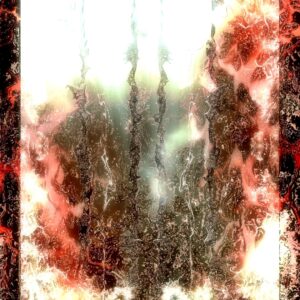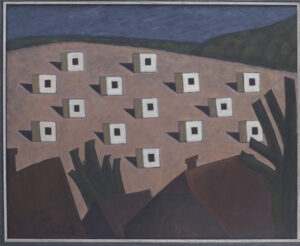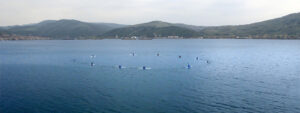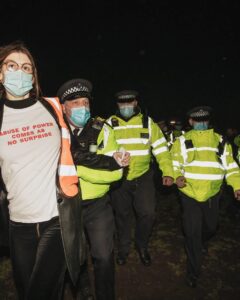The attacks on documenta fifteen began eight months ago, in January 2022, when the WordPress blog of the ‘Alliance against Anti-Semitism Kassel’ accused ruangrupa, the Indonesian collective curating the current edition, some members of the artistic team and one of the invited collectives, The Question of Funding (TQoF), of antisemitism. As pointed out in the open letter written together with the curators of the now cancelled forum We need to Talk!, the ‘Alliance against Anti-Semitism Kassel’ seems to have only one member. Besides claiming to be ‘against Islam, but not in a racist way’ the blog feels the need to point out that ‘Lumbung’ is not ‘an alcoholic mixed drink’,[1]—referring to ‘Lumumba’, in Germany the racist name for a cocoa and rum cocktail that mocks the ill-fated Congolese independence leader Patrice Lumumba—but ‘a collectively managed rice barn’ which ‘is as much a part of Java’s village culture as the lynching of the Chinese grocer’ (emphasis added).
The same blog post accuses two members of ruangrupa, Ade Darmawan, misspelt as Ada Darmawan, and Farid Rakun, respectively of:
1) supporting ‘A Letter Against Apartheid’, which calls for an ‘immediate and unconditional cessation of Israeli violence against Palestinians,’ and which gathered more than 16,000 signatories, and
2) of signing the ‘Open letter to the Fundação Bienal São Paulo’, misspelt as ‘Funacao Bienal des Sao Paulo’, a letter by participating artists in this event protesting the organiser’s acceptance of Israeli funding.
Neither of these accusations involve antisemitism. Supporting the BDS movement or other forms of protest against Israeli policies are forms of political expression. Granted, every instrument used to exert political pressure can have unsought consequences, e.g., every time the BVG declares strike action, Polish cleaners in the gig economy cannot make it to work and are thus unfairly punished. Yet these outcomes, however unwelcome, do not in my view delegitimize the right to strike. It might also seem petty of me to list the blog’s misspellings, but misspelling or mispronouncing foreign names—especially when these are compounded by abject jokes—tends to connote casual racism. Needless to say, the ‘Alliance against Anti-Semitism Kassel’ wouldn’t tolerate bile this overt and hateful if it were directed at Jews.
Other than a vague link between the Ramallah-based Khalil Sakakini Cultural Centre, named after Khalil al-Sakakini, a Palestinian poet and Arab nationalist whose alignment with National Socialism is debatable, the accusations of antisemitism were never fleshed out. But they didn’t need to be.
Though one would not expect unsubstantiated accusations originating in a disreputable source to be reproduced by mainstream media, this is exactly what happened. To simply report on the reports was apparently enough to meet journalistic standards. It went more or less like this: ‘documenta fifteen is accused of antisemitism’; ‘accusations of antisemitism keep dogging document fifteen’; ‘multiple outlets accuse documenta fifteen of antisemitism’; ‘documenta fifteen is facing widespread controversy’. Overwhelmed by the media frenzy, the documenta management tried to counter the stream of attacks by engaging an advisory committee, which sought to parse out the difference between criticising the Israeli state’s policies and indulging antisemitic impulses. The already mentioned forum We Need to Talk!, a series of talks that aimed at contextualizing antisemitism in relation to anti-Black racism and anti-Muslim racism, was a result of these good faith efforts to mediate between documenta, and the artists it had invited, and German opinion leadership. But the forum was hastily cancelled after the president of the Central Council of Jews in Germany, Josef Schuster, accused the orientation of the panels of having a ‘clear bias to the disadvantage of anti-Semitism’.
After the forum’s cancelation, ruangrupa issued a statement saying they would rather let the art speak for itself. And the art spoke. But it said something rather unexpected.
I am not going to dispute whether the Jewish figure in Taring Padi’s mural ‘People Justice” is antisemitic: it is. I would simply note it appears next to intensely misogynistic depictions of women with forked tongues and an emasculated man doing a handstand on a supermarket trolley while suckling a pacifier. Immediately below there is a pig-faced GI holding his ejaculating penis. These bother me more than the antisemitic figure because they do not seem to bother anyone else. Overall, the mural is perhaps hard to like. But it’s also difficult to be ‘for’ or ‘against’ it. Satire and caricature can foster mobilisation and militancy by articulating a collective identity. But the process of defining an identity is often predicated on the absence of empathy, and on an attendant process of exclusion from the community. Political satire tends to personify abstract enemies—greed, corruption, consumerism or financial markets—as concrete entities like Jews or monstrous women and their kept men. It inheres in the conventions of the genre to easily slide into abject stereotypes. Those are its conditions of legibility. To treat political subjection as a failure of masculinity or to embody financial abstraction in the figure of the Jew are tropes that cut across the political spectrum, leaving emancipatory projects marooned in reactionary iconography. We could say, taking license with Andrea Dworkin’s statement, that ‘the Left cannot have its whores and its politics too’. But we could also say that things are complicated, that political change and cultural change might not work in tandem, that denaturalising power relations might be easier than denaturalising gender relations and entrenched racial prejudices, or that the merits or demerits of political artworks, many of which come laden with harrowing backstories, cannot be measured against the yardstick of semiotic theory.
Either way, what this author would not say is that the mural has the power to warp time to retroactively substantiate the unsubstantiated accusations, as if the accusers had some deeply perceptive foresight when, in fact, they simply got lucky. I wouldn’t try to defend it via appeals to the specificity of its context of origin either, nor would I stretch a rhetorical cordon sanitaire around Taring Padi to save the remainder of the show, pitting good anti-Zionist art against bad antisemitic art. What happened with ‘People’s Justice’ was unfortunate but perhaps unavoidable, as it inheres in ruangrupa’s proposition to surrender curatorial oversight for art to serve as a means of intervention. This is, on the one hand, documenta fifteen’s strength and the reason it has such a vibrant energy. It is also the exhibition’s weakness in the sense that its decentralised approach renders it vulnerable to such lapses of judgement. This is however not a reason to evacuate its premise. Writing about documenta fourteen, Andrew Wiener argued that ‘fundamental power imbalances… can’t simply be curated away’, and indeed that to dispel stubborn asymmetries one might need to surrender curatorial oversight altogether and allow the exhibition to grow organically.
This is also, I would venture, the reason for so much anti-documenta sentiment in Germany: ruangrupa’s proposition threatens established business models and the subjectivities these business models engender: In the case of an artwork, it is, paradoxically, the appeal to a value beyond its monetary value that functions as a guarantee of said art’s monetary value. Artworks are at once a ‘priceless and universal good, and one subject to proprietary laws’.[2] But this gap between different modalities of value needs to be mediated by individuated artistic personas and the concept of artistic autonomy. These are precisely the categories that, by focusing on art as a socially engaged practice, documenta fifteen does away.
It is interesting, if incongruous, that those who decry documenta, tend to equate its sociogenic proposition with antisemitism. In an article for Merkur that could be described as the high-brow version of the ‘Alliance against Anti-Semitism Kassel’ blog posts, Jan von Brevern sees the shadow of fascism looming large upon documenta’s ‘anti-modernist utopia’ fed by the ‘Rousseauian and romantic longings’, which according to the author captivated communists and National Socialists alike. There is indeed a romantic critique of modernity, whose rhetorical operations became crucial for fascism. It is one that displaced the socialist concept of alienation—the alienation of land into property; the alienation of workers from the products of their labour—to foreground instead the alienation from authenticity—the alienation from one’s authentic self; one’s authentic way of life. I would dispute, however, the author’s notion that liberalism is antithetical rather than contiguous to romanticism, not to mention the assumption that documenta articulates a romantic critique of modernity, laden with nostalgia and folksy leanings. On the contrary, I would say the exhibition shifts the foundations upon which debates about folk culture and cultural legacies can be staged to develop an alternative account of tradition, one that acknowledges the plurality of lived experience, and the multi-layered origins of customs and histories, rather than foregrounding an ossified concept of cultural identity. The notion that small-scale communities must be either innocent and guileless or thuggish and controlling does not represent any de facto community, it just represents the two facets of a reactionary, antidemocratic, debate about the nature of society that has been stifling Europe since the eighteenth century.[3] There is a lot of projection going on in these accusations, and I mean projection in the sense of misinterpreting the cultural distortions and malignant social formations located within western culture as somehow coming from without. There is also a lot of unacknowledged hypocrisy.
Were German opinion makers sincerely preoccupied with antisemitism they would not, for instance, depict Facebook CEO Mark Zuckerberg as a hook-nosed octopus (Süddeutsche Zeitung, 21 February 2014). The same paper dismissed the cartoonist Dieter Hanitzsch because of a satirical image of Israeli Prime Minister Benjamin Netanyahu announcing the Israeli Netta Barzilai’s victory at Eurovision 2018. That Hanitzsch’s cartoon, and none other, led to a dismissal, tells you all you need to know about how criticism of Israel tends to attract more opprobrium than actual antisemitism. One could also point out that mainstream media hardly paid attention to the antisemitic tropes disseminated by the German anti-lockdown movement, whose members attempted to storm the Parliament on 29 August 2020. From narratives of reverse colonisation involving the subjugation of white Germans to a State representing the interests of global finance to the on-the-nose personifications of said finance as George Soros, these also included conspiracy theories claiming that the virus is a Sino-Jewish hoax, or that vaccines have been developed by a Jewish cabal to microchip, and subsequently control, the white population.
It would be impossible here to make one extensive list, but one further example is pertinent to mention. The magazine Jungle World, the unofficial organ of the antiDeutsch movement, defended a sculpture titled Tankie Meme (Blacked) by the Canadian artist Mathieu Malouf that traffics in antisemitic tropes. Though Jungle World itself called it ‘a grotesquely exaggerated anti-Semitic sculpture’, it argued that the sculpture is not antisemitic because it is ‘a caricature of a caricature” influenced by meme culture. At the same time, the magazine scolded those who critiqued the artist for their ‘frivolous attempts’ to stoke ‘outrage’. Since Taring Padi’s figure is also ‘a grotesquely exaggerated antisemitic’ image, one wonders why Jungle World wouldn’t also ask here what ‘this frivolity is supposed to achieve, apart from generating attention in the form of outrage’.[4] This is a rhetorical question. For Jungle World, People’s Justice is not art, it is just propaganda (‘das ist keine Kunst, sondern Propaganda’). Perhaps this is because the Taring Padi mural was not inspired by meme culture, or because its author is not Canadian. Or perhaps it’s because the Taring Padi mural’s earnestness makes it impossible to appeal to irony’s ability to derail ethical questions. Or because Jungle World believes ‘hostility to Israel is considered en vogue in the international art world, anyone who doesn’t go along with it comes under pressure’. Either way for Jungle World, People’s Justice is not ‘a caricature of a caricature’, it’s just a caricature—i.e. not art, but propaganda.
Once it became established that we are not dealing with ‘art’, the debate around documenta fifteen swiftly slid into calls for state scrutiny, which are simply veiled calls for censorship. So much is apparent in the cultural ministry’s five-point plan for future editions: ‘In the future, financial support from the federal government should therefore be linked to direct involvement in the structures of documenta’. In order to ‘ensure that no further antisemitic works are exhibited at documenta’ the central council of Jews is also granted supervisory powers over the ‘documenta and in its management’. The five-point plan is informally compounded by a debate (or rather by the absence thereof) which has already established that any attempt to address contested histories falls under the scope of propaganda, thus deeming works such as the Archives des Luttes des Femmes en Algérie (Archives of Women’s Struggles in Algeria), Subversive Film or The Question of Funding, unfit for exhibition unless it is, in the words of art critic Jörg Heiser, ‘made accessible to allow explorations of the logic and history of propaganda iconography’. In the latest development the advisory panel (Julia Bernstein, Marina Chernivsky, Nicole Deitelhoff, Peter Jelavich and Christoph Möllers) engaged by the stakeholders of documenta GmbH called for the prompt removal of the Tokyo Reels: ‘the most urgent task from the panel’s point of view is to stop the screening of the compilation of pro-Palestinian propaganda films from the 1960s–1980s by the collective “Subversive Film”, shown under the name Tokyo Reels Film Festival’. (emphasis added) Contrary to what one would expect, in a country whose recent history is replete with a pattern of political persecution, German mainstream media did not seem to find this open call for State censorship alarming.[5]
Ironically, in recent years a great many authors, journalists, artists and institutions have rallied around the defence of ‘artistic freedom’ and ‘free speech’ that is allegedly imperilled by the moralistic creep of ‘identity politics’ or what is colloquially known as ‘cancel culture’. But principles, as Donald Kinder and Tali Mendelberg argue, are best understood in how they are ‘put to use’, how they are employed and for what ends.[6] ‘A Letter on Justice and Open Debate’ published by Harper’s magazine on 7 July 2020, perfectly illustrates this point. Written against the backdrop of the BLM protests and an epidemic that laid bare the structural racism of western societies, the authors seek to ‘uphold the value of robust and even caustic counter-speech from all quarters’. That these protections do not extend to pro-Palestinian activists or supporters of the BDS movement is made glaringly obvious by the great number of signatories who actively campaigned to oust Muslim scholars from American academia. This is not a minor detail or an ad hominem attack; this is a structural question insofar as it points to the content of ‘free speech’, and indeed to the cultural policies it enables. This is why the Danish newspaper Jyllands-Posten’s controversial publication of twelve cartoons depicting Muhammad, in 2005, was understood as a legitimate exercise of free speech rather than an expression of animosity towards Muslim minorities in Europe.
The way antisemitism is framed in Germany masks an intense racial animosity and resentment towards changing demographics. Accusations of antisemitism, typically hurled at non-white artists or intellectuals are a convenient way to mask systemic racism as anti-racism. They enable institutions to maintain and protect white hegemony while submitting non-Europeans to scrutiny and smears, all under the pretext of taking a principled stance against antisemitism. By embracing an exclusionary form of memory politics, they also contribute to the silencing and marginalisation of the Israeli and Jewish left, and by extension all postcolonial positions, as the Mbembe case made clear. As is the case with the ‘Alliance against Anti-Semitism Kassel’, the preoccupation with antisemitism often goes hand in hand with anti-Muslim and anti-Black racism, to the point one could argue the former is often just a cover for the latter. It is no coincidence that the coming director of HKW Bonaventure Soh Bejeng Ndikung’s name is constantly dragged into these controversies, or that even the late curator Okwui Enwezor was thrown under this bus in a somewhat gratuitous manner in an article by Hito Steyerl ironically entitled ‘Context is Everything’.
Context is indeed everything but what constitutes context is debatable: To this day, the discussion in Germany is predicated on a differential logic, which contrasts Nazi crimes, deemed irrational by virtue of their uneconomical nature, and colonial crimes, deemed rational because they were driven by economic interests. This narrative arches back to the post-war reconceptualization of fascism, as a negation or distortion of modernity, not one of its constitutive features.
In his famous essay Discourse on Colonialism, the poet Aimé Césaire argued that what in Europe is called ‘fascism’ is just colonial violence finding its way back home. But his warnings went unheeded. More widely read was The Authoritarian Personality by Theodor W. Adorno et al. Published in 1950, the same year as Discourse on Colonialism, it developed the F-scale (F for fascist) in order to gauge the psychological predisposition for fascism among the democratic citizenry, contributing to the post-war consensus that fascism was a personality trait, resulting from the devolution of the individuated liberal subject. Still dominant today, this tendency to psychologize fascism fails to incorporate the colonial dimension, obscuring the continuities between fascism and the biopolitics of empire, in the process ultimately depoliticizing both. The recent resurgence of fascism under figures such as Jair Bolsonaro, Rodrigo Duterte or Donald Trump has been narrated along these lines, as a descent into lunacy or outburst of unfocused anger, spilling into the public sphere, running rampant over middle-class civility. In Germany in particular, this decontextualization of fascism obscures the continuities between the Kaiserreich, or Second Reich and the Third Reich, eliding the Herero and Namaqua genocides. German tardiness in addressing the crimes committed under Kaiser Wilhelm II finds a parallel in the French failure to acknowledge colonial crimes in Algeria, the British genocide in Kenya or the US’s halting attempts to account for segregation, racial violence and lynchings. When Raphael Lemkin, the Polish lawyer known for coining the term ‘genocide’ and for initiating the Genocide Convention, first addressed the UN, CPA-backed Civil Rights Congress, led by African-American lawyer William Patterson, put forth their own petition: We Charge Genocide: The Historic Petition to the United Nations for Relief from a Crime of the United States Government Against the Negro People. But the Truman administration aggressively pushed against it, leading Lemkin, who feared for the ratification of his convention by the US government, to deny that US racial policies could fall under his conceptualisation of genocide.[7]
In all these cases, white supremacy, as Charles W. Mills contends, is never ‘seen as a political system’, it is just the backdrop against which ‘other systems, which we are to see as political’, like fascism or social democracy, play out.[8] But as Mills sustains, white supremacy is a political ideology, and arguably the most important political ideology of modernity. In Germany, meanwhile, antisemitism is both the way race is experienced and the way race is occluded.
To put it in simpler terms: antisemitism is the way a global cultural war plays out locally. What Germany defends is not its Jewish citizenry—the unhinged attacks on the writer Emily Dische-Becker should dispel any doubt about this—but a specific regulative discourse upon which ‘the racial, order of modernity rests’.[9] Echoing the arguments laid out by the ‘Alliance against Antisemitism Kassel’, who describe documenta fifteen as ‘the postcolonial romantic transfiguration of blood and soil’ and von Brevern’s ‘Asian rural idyll’, in an article for FAZ Claudius Seidl triangulates the Berlin Biennial, the HKW and the documenta to argue that contemporary art has a Jewish problem. Misrepresenting the content of a conference I co-curated with Anselm Franke, ‘Whose Universal?’, Seidl complains that in our ‘supposedly primordial, indigenous, natural and unmixed’, anti-modern world ‘cosmopolitan Jews really have no place’. For Seidl, too, apparently, nothing exists outside the dichotomy ‘Western modernity’ vs ‘tribal primordialism’, thus any critique of Western modernity would lead to romantic, that is proto-fascist, positions. It is either Enlightenment or darkness. In his documenta address, transmitted live on the 18 June 2022 by the broadcaster tagesschau24, German president Frank-Walter Steinmeier also ventured into these sunken places: ‘In Indonesia’, he recounted, he has ‘seen how—and under what conditions—people live on seemingly endless rubbish dumps’. Steinmeier recognises the garbage originates in Europe, but he fails to mention this is a product of what Andre Gunder Frank calls ‘the development of underdevelopment’, that is, the active process of underdeveloping the periphery to the benefit of the imperial centres like Germany, and thus part of the structural relationship that characterizes capitalism.[10] It is this structural relation, not ‘cottagecore’ or rural fantasies, that documenta fifteen thematises. And the world has known plenty of cosmopolitan market economies in spite of what Seidl or von Brevern believe. These blind spots do not simply lead to unfair criticism, they also point to the latent content of their pronouncements: it is not the Jews who have no place outside of Western modernity. So much is also apparent in the following exchange between Süddeutsche journalist Jörg Häntzschel—one of the few journalists who spoke to the curators rather than speaking for them—and documenta curator Farid Rakun:
JH: As a visitor, you sometimes ask yourself: Am I a participant in a dialogue or just a fence-sitter at a meeting of groups from the ‘Global South’?
FR: Now you know how we, the marginalised, always felt: as onlookers!
In the same interview, Rakun points out that the function of the accusations of antisemitism is to conceal racism. But neither racism nor its concealment have been addressed in the media coverage. The discussion about the semiotic violence present in People’s Justice also took precedence over addressing the material violence to which the artists who partook in the documenta were subjected, including vandalism, death threats and physical harassment, but also the less palpable structural violence of ninety day visas or even visa denials. It is also interesting to me that what seems to frustrate the viewer’s gaze is the inability to capture the totality of the exhibition, and that as a result the accusations of antisemitism are often entangled with accusations of opacity and anarchy. Quoting Toni Morrison, Rakun contended that the function of racism is to ‘keep you from doing your work. It keeps you explaining why you are the way you are’. Needless to say no amount of explaining, or apologising will do.
To this day, the legacies of colonialism tend to find expression in a language contemporary audiences find familiar and compelling, and hence remains largely unquestioned. Saturated by colonial formations, principles like openness, universalism, humanism, freedom and individualism function in lockstep with the development of a globally-integrated economy rooted in Western hegemony. No wonder documenta feels so threatening: it is a beacon of de-Westernization, a process that is not only playing out culturally but also geopolitically. In a weird kind of way, the documenta could be construed as yet another Ukraine war casualty, and here I don’t simply mean that Steinmeier might have singled out document fifteen to sanitise his image after being rebuffed by the Ukrainian president. After the Russian invasion, a certain type of subjectivity, mostly white and predominantly male, which was on the verge of coming undone, came back with a vengeance. It is now again possible to say ‘Western values’ with a straight face. Masculinity appears no longer as the problem but the solution— hence the renewed assertiveness. A great many increasingly obsolete or irrelevant positions found a renewed relevancy by latching on to this discussion, which afforded them the opportunity of reconstructing their identities, in order to be on the right(eous) side of history.
As affect theorist Lauren Berlant argues,[11] the attachments that help reproduce what is most damaging in the world are at the same time those that hold the world together as a coherent representation. Giving up one’s attachments, however cruel or toxic, would mean giving up the world and one’s position in it. This, not antisemitism, is the real reason why, as documenta’s curators point out, ‘the criticism and accusations never stop’. To return to Farid Rakun’s statement by way of conclusion, ‘there doesn’t seem to be a satisfactory answer here’ because this is not a debate, this is the expression of a wounded narcissism, unable to divest itself from a pleasurable investment in the (increasingly besieged) notion of its own universality.[12]
Notes
[1] In the original: ‘Die ruangrupa hat das sogenannte „lumbung” ins Leben gerufen, was kein alkoholisches Mischgetränk ist, sondern „kollektiv verwaltete Reisscheune” bedeutet’.
[2] Nicole Demby, ‘Art, Value and the Freedom Fetish’, Mute Magazine, 28 May 2015: https://www.metamute.org/
[3] David Graeber and David Wengrow’s recent book The Dawn of Everything (Penguin, 2021) contends that such theories, Rousseauean and Hobbesian alike, first emerged in the eighteenth century as a conservative reaction to powerful critiques of European society posed by Indigenous observers and intellectuals.
[4] In the original: Der US-amerikanische Künstler Mathieu Malouf, mit dem Sie in Berlin auch bereits über das Thema »cancel culture« diskutiert haben, hat einen kleinen Skandal verursacht, indem er eine grotesk überzeichnete antisemitische Skulptur in einer Galerie in Los Angeles ausgestellt hat. Es war auf den ersten Blick zwar durchaus zu erahnen, dass es sich dabei gewissermaßen um die Karikatur einer Karikatur handelte, und der Einfluss der Meme-Kultur war ebenfalls zu erkennen. Dennoch bleibt die Frage, was diese Frivolität leisten soll, außer Aufmerksamkeit in Form von Empörung zu generieren.
[5] Not content with deferring to the censors, the artists responded with an open letter.
[6] Donald Kinder and Tali Mendelberg, “Individualism Reconsidered: Principles and Prejudice in Contemporary American Opinion.” In: David O. Sears, James Sidanius, and Lawrence Bobo (eds.) Racialized Politics: The Debate about Racism in America (Chicago: University of Chicago Press, 2000), p. 73.
[7] A. Dirk Moses, The Problems of Genocide: Permanent Security and the Language of Transgression (Cambridge: Cambridge University Press, 2021), pp. 398–405.
[8] Charles W. Mills, The Racial Contract (Ithaca: Cornell University Press, 1997), p. 1.
[9] David Lloyd, Under Representation: The Racial Regime of Aesthetics (New York: Fordham University Press, 2018), p. 3.
[10] See, for instance, Utsa Patnaik and Prabhat Patnaik, A Theory of Imperialism (New York: Columbia University Press, 2016).
[11] See: Lauren Berlant, Cruel Optimism (Durham, NC: Duke University Press, 2011).
[12] See Lloyd, Under Representation.
Header image
Taring Padi’s mural ‘People Justice” covered with black fabric as seen at documenta fifteen on 21 June 2022 (photograph by Michael Paetzold; licence: Creative Commons by-sa-4.0)
About the author
Ana Teixeira Pinto is a writer and cultural theorist based in Berlin. She is a professor of Art theory at the HBK Braunschweig and a theory tutor at the DAI (Dutch Art Institute) and her writings have appeared in publications such as Artforum, Third Text, Afterall, e-flux journal, Manifesta Journal, and Texte zur Kunst. She is the editor of the book series On the Antipolitical, published by Sternberg Press. Together with Kader Attia and Anselm Franke, she co-organized the conference and podcast series The White West: Whose Universal, which took place at HKW Berlin in collaboration with the 2022 Berlin Biennial.
Cite as
Ana Teixeira Pinto. “This is why we can’t have nice things!” JVC Magazine, 4 October 2022, https://www.journalofvisualculture.org/this-is-why-we-cant-have-nice-things/





